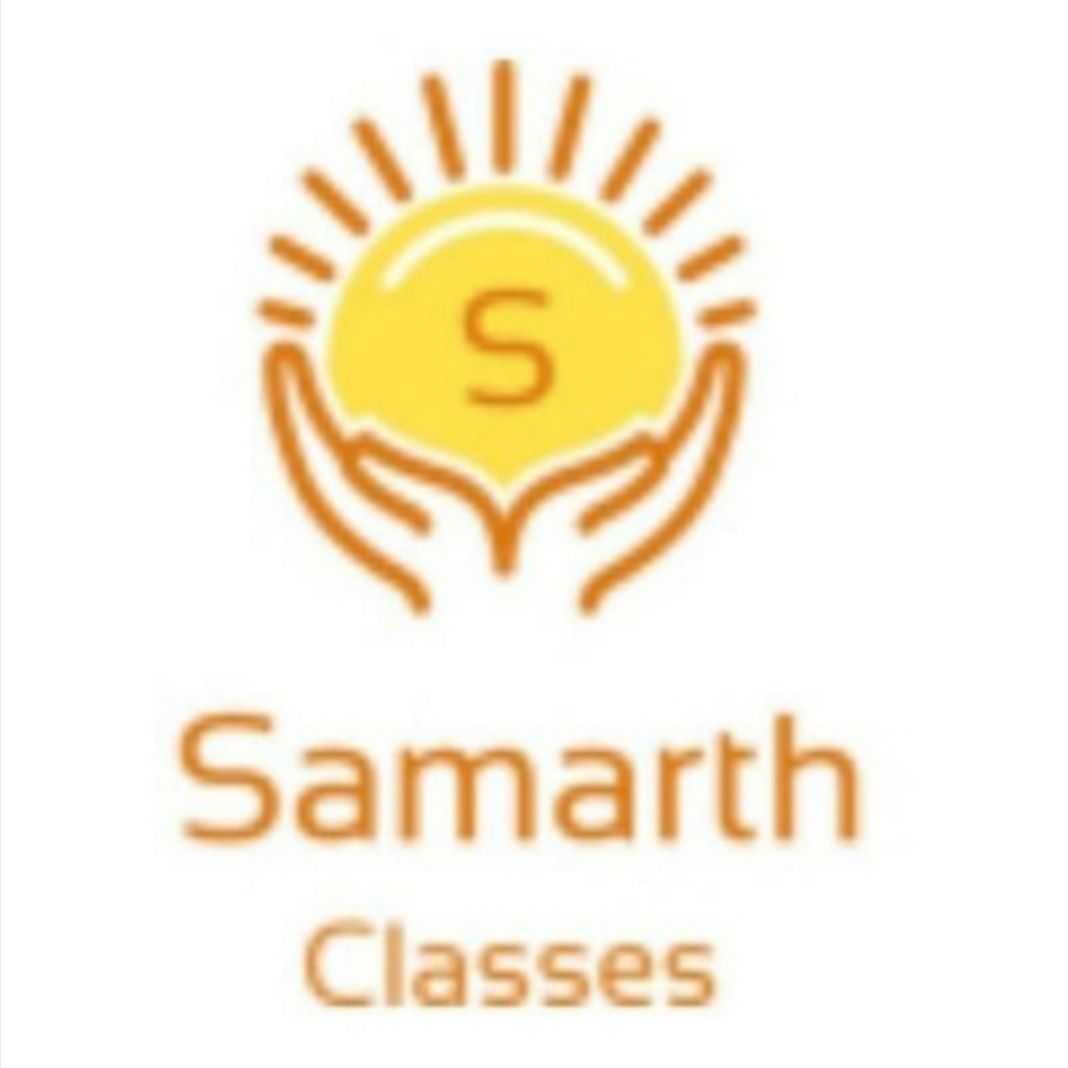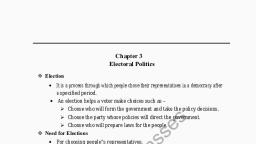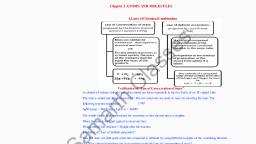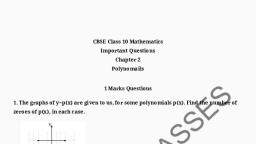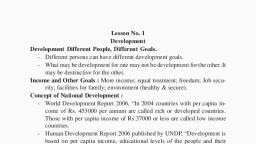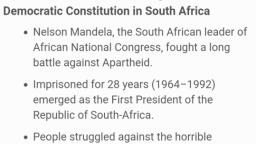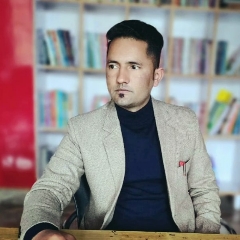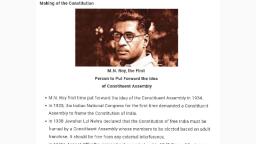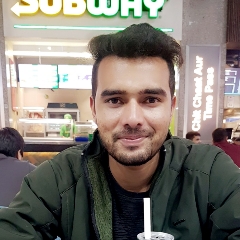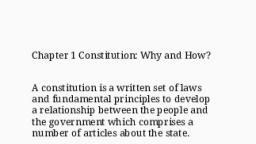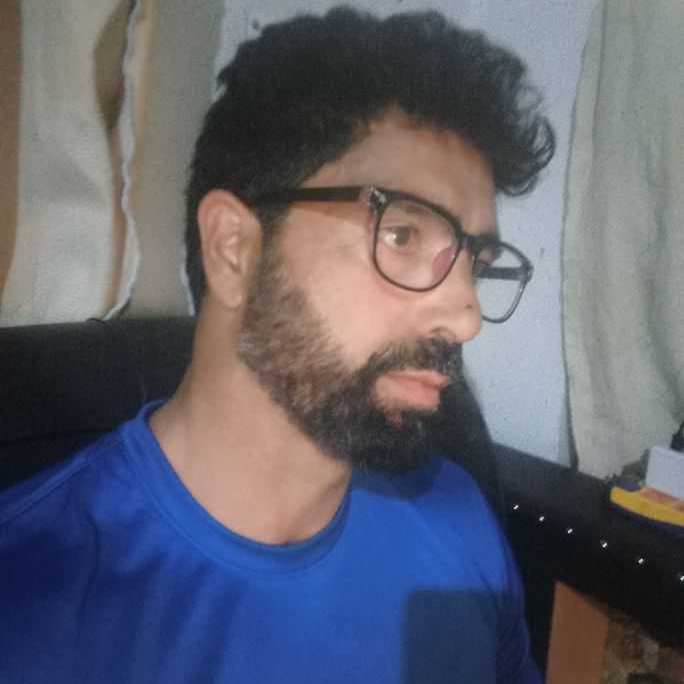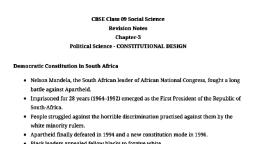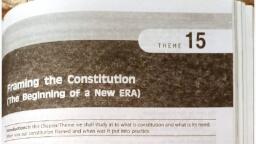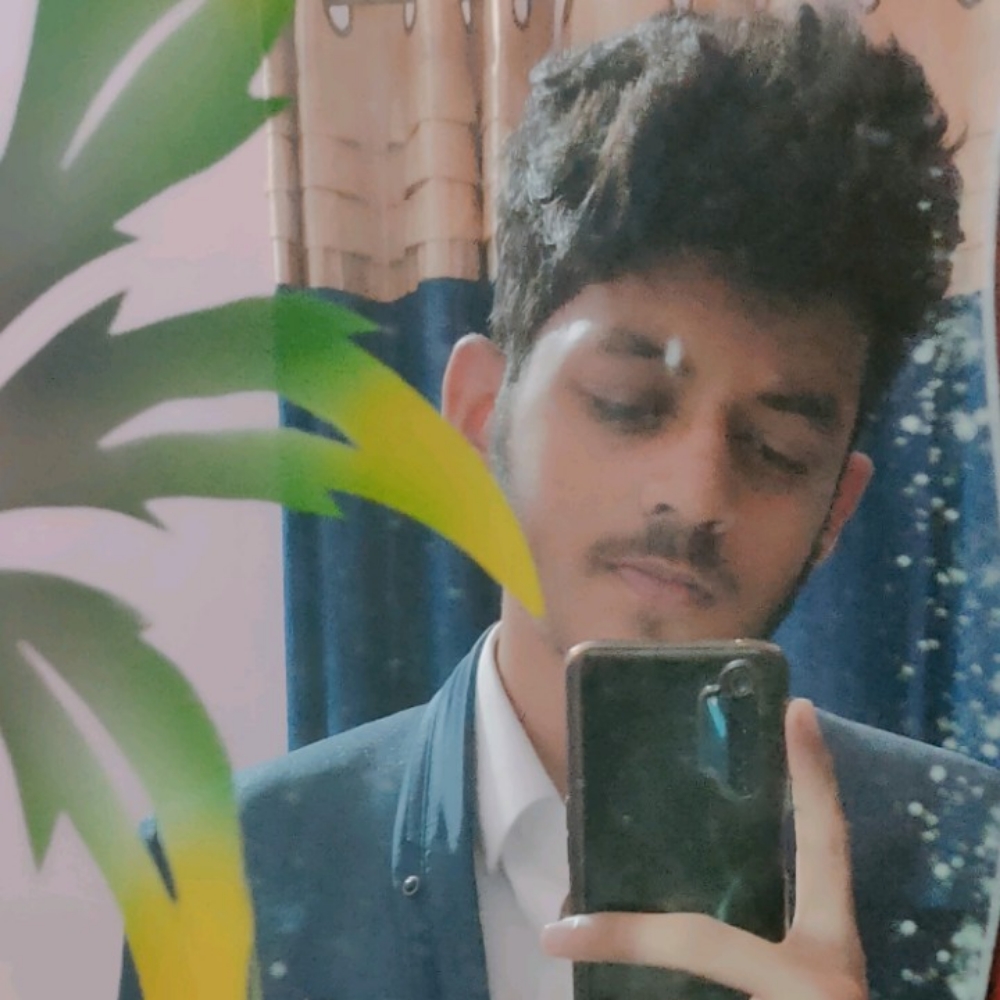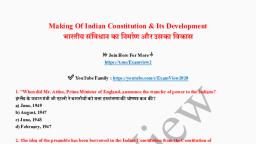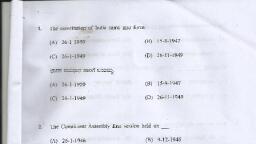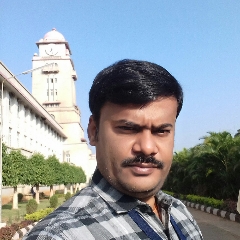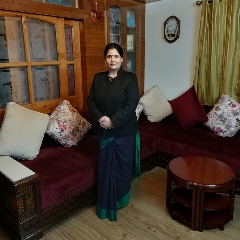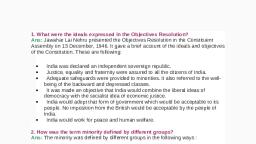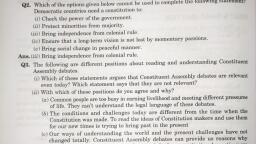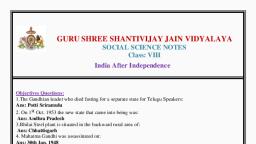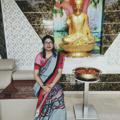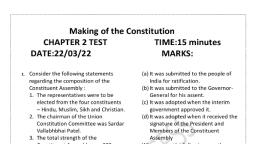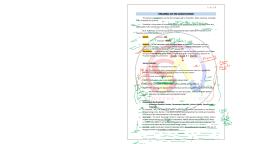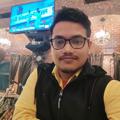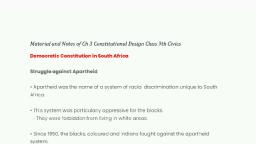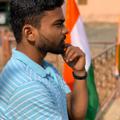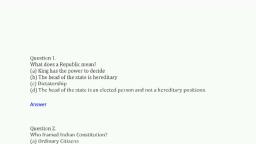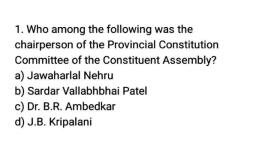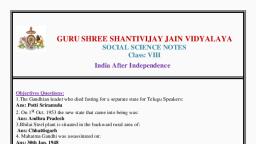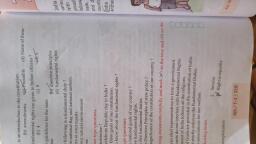Page 1 :
Chapter-3, Constitutional Design, 1 marks Questions, 1. When was the constitution of India passed by the Constituent Assembly?, Ans. 26th November, 1949., , 2. When was the constitution of India adopted?, Ans. 26th November, 1949., , 3. When was the constitution of India enforced?, Ans. 26th January, 1950., , 4. In which year reorganization of states on linguistic basis becomes a reality?, Ans. 1956., , 5. Who was H.P. Modi?, Ans. He represented the Parsee Community in the constituent Assembly., , 6. What is Clouse?, Ans. A distinct section of a document., , 7. How many members are there in the Constituent Assembly that wrote the Indian, Constitution?, Ans. 299 members.
Page 2 :
8. Who are called black in South Africa?, Ans. The native people of South Africa are black., , 9. Who was Nelson Mandela?, Ans. He was the leader of African national Congress. He was the main leader of nationalist, struggle. He remained in jail for 28 years., , 10. What is Apartheid?, Ans. The official policy of racial discrimination and till treatment of blacks followed by the, government of South Africa between the years of 1948 to 1989., , 11. What is Draft?, Ans. A preliminary version of legal document., , 12. Define Tryst., Ans. Meeting or meeting place that has been agreed upon., , 13. Who was the first one to draft a constitution for India?, Ans. In 1928, MotiLal Nehru and eight other congress leaders drafted a constitution for, India., , 14. What resolution was made in 1931, Karachi Session?, Ans. How independent India’s constitution should look like., , 15. What is the name of the autobiography written by Nelson Mandela?, Ans. The Long March to Freedom.
Page 3 :
16. What was the name of the party which won freedom in South Africa?, Ans. African National Congress., , 17. When were the elections for the Constituent Assembly held in India?, Ans. July 1946., , 18. Who was the chairman of constituent Assembly?, Ans. Dr Rajinder Prasad., , 19. Who was the Chairman of the Drafting Committee?, Ans. Dr B.R. Ambedkar., , 20. Who was the Viceroy of India when India became free?, Ans. Lord Mount Batten.
Page 4 :
3 marks Questions, 1. ‘The authority of the rules of the constitution is the same as that of any other law’., Explain., Ans. It is true that the constitution is the supreme law of a country., It is the foundation of a democratic entity., The rules laid down in the constitution are basis on which all the other laws are framed., It follows that the constitutional rules have the same authority, perhaps even greater, as any, other law of a country., , 2. What do understand by constitutional amendment?, Ans. The constitution of India is long and detailed documents. It needs to be amended quit, regularly to keep it updated., The makers of the constitution felt that it has to be in accordance with people’s aspirations, and changes in society., They did not see it as a scared, static and unalterable law., So it is the provision of change in constitution made by the supreme legislative body in a, country., , 3. Mention the main point of Nehru’s famous speech that he made to the Constituent, Assembly?, Ans. To dedicate oneself to the service of India and her people., To understand that freedom and power mean responsibility to remove the suffering of the, people., Understand that the service of India means service of the millions who suffer. It means, ending their poverty, ignorance, disease and inequality of opportunity.
Page 5 :
4. What is the importance of Preamble of the Constitution?, Ans. The Preamble of the constitution is important because it contains the philosophy on, which the entire Constitution has been built., It provides a standard to examine and evaluate any law and action of government to find, whether it is good or bad., It is the soul of the Indian constitution., , 5. Explain the Gandhiji’s dream of India., Ans. Gandhiji strive for a constitution which will release India from all thralldom and, patronage., India in which the poorest shall feel that it is their country in whose making they have an, effective voice., An India in which there shall be no high class and low class of people., An India in which all communities shall live in perfect harmony., , 6. Who was Vallabhbhai Jhaverbhai patel?, Ans. He was born (1875-1950) in Gujarat., Home Minister, Information and broadcasting minister., Lawyer and leader of Bardoli peasant Satyagraha., Played a decisive role in the integration of the Indian princely states. Later he became, Deputy Home minister., , 7. What do you know about Abul Kalam Azad?, Ans. Abul Kalam Azad (1888-1958)Born-Saudi Arabia., Educationist, author, and theologies:, Scholar of Arabic., Congress leader, active in the national movement., Opposed Muslim separatist politics., Later education minister in the first union cabinet.
Page 6 :
8. What do you know about T.T. Krishnamachari?, Ans. T.T. Krishnamachari (1899-1974)Born- Tamil Nadu., Member of Drafting Committee., Entrepreneur and congress leader., Later finance Minister in the Union Cabinet., , 9. What do you know about Rajendra Prasad?, Ans. Rajendra Prasad (1884-1963)Born-Bihar., Chairman of the Constituent Assembly., Lawyer, known for his role in the Champaran Satyagraha., Three time President of Congress., Later the first president of India., , 10. What do you know about Jaipal Singh?, Ans. Jaipal Singh (1903-1970)Born- Jharkhand., A sportsman and educationist., Captain of the first national Hockey TeamFounder president of Adivasi Maha Sabha., Later founder Jharkhand Party., , 11. What do you know about H.C. Mookherjee?, Ans. H.C. Mookherjee (1887-1956)Born Bengal., Vice Chairman of the Constituent Assemble., Reputed Author and educationist., Congress Leader., Member of All India Christian Council and Bengal Legislative Assemble., Later Governor of West Bengal., , 12. What do you know about G. Durgabai Deshmukh?, Ans. G. Durgabai Deshmukh (1909-1981)Born- Andhra Pradesh., Advocate and Public Activist for women’s emancipation.
Page 7 :
Founder Andhra Mahila Sabha., Congress Leader., Later Founder Chairperson of Central Social Welfare Board., , 13. What do you know about Baldev Singh?, Ans. Baldev Singh(1901-1961)Born-Haryana., A successful entrepreneur a leader of the Panthic Akali Party in the Punjab Assembly., A nominee of the Congress in the Constituent Assembly., Later: Defence Minister in the Union Cabinet., , 14. What do you know about Kanhaiyalal Maniklal Munshi?, Ans. Kanhaiyalal Maniklal Munshi(1887-1971)., Born-Gujarat., Advocate historian and linguist., Congress leader and Gandhian., Later: Minister in the Union Cabinet., Founder of the Swatantra Party., , 15. What do you know about Bhimrao Ramji Ambedkar?, Ans. Bhimrao Ramji Ambedkar (1891-1956)., Born-Madhya Pradesh., Chairman of the Drafting Committee., Social revolutionary thinker and agitator against caste divisions and caste based inequalities., Later: Law minister in the first cabinet of post-independence India., Founder of Republican Party of India., , 16. What do you know about Shyama Prasad Mukherjee?, Ans. Shyama Prasad Mukherjee (1901-1953)., Born-West Bengal., Minister for Industry and Supply in the Interim Government.
Page 8 :
Educationist and lawyer., Active in Hindu Mahasabha., Later: Founder President of Bharatiya Jansangh., , 17. What do you know about Jawaharlal Nehru?, Ans. Jawaharlal Nehru (1889-1964)., Born-Uttar Pradesh., Prime Minister of the interim government., Lawyer and Congress leader., Advocate of socialism, democracy and anti-imperialism., Later: First Prime Minister of India., , 18. What do you know about Sarojini Naidu?, Ans. Sarojini Naidu (1879-1949)., Born Andhra Pradesh., Poet, writer, and political activist., Among the foremost women leaders in the congress., Later Governor of Uttar Pradesh, , 19. What do you know about Somnath Lahiri?, Ans. Somnath lahiri ( 1901-1984), Born- West Bengal, Writer and Editor., Leader of Communist Party of India., Later member of West Bengal legislative Assembly, , 20. Write about the preamble of US., Ans. We the people of United States, in order to form a more perfect union, establish justice,, insecure domestic tranquility., Provide for the common defense, promote the general welfare, and secure the blessings of
Page 9 :
liberty to ourselves and our posterity., Do ordain and establish the constitution for the United States of America., , 21. What do you understand by the term apartheid?, Ans. Apartheid refers to the official policy of racial separation and ill treatment of blacks, followed by the white government of South Africa between 1948 and 1989., This practice of racial discrimination remained for the longest period in South Africa., , 22. What basic rules are followed to form a Constitution?, Ans. The rulers should lay down how the rulers are to be chosen in future., These rules should also determine what the elected governments are empowered to do and, what they cannot do., These rules should decide the rights of the citizens., , 23. What documents were taken by the constituent Assembly to form the Indian, Constitution?, Ans. The Indian Constitution was drafted by Moti Lal Nehru and eight other leaders in 1928., The resolution at the Karachi Session of the Indian national Congress on how independent, India’s Constitution should look like in 1931., , 24.How was Constituent Assembly formed?, Ans. The drafting of the document called the constitution was done by an assembly elected, representatives called Constituent Assembly., Elections to Constituent Assembly were held in July 1946., Its first meeting was held in December 1946., The Constituent Assembly was also divided into the Constituent Assembly of India and, Pakistan after the Partition., The Constituent Assembly that wrote the Indian Constitution constituted as many as 299, members.
Page 10 :
25. When was the Constitution completed and why was it imposed on 26 January 1950?, Ans. The Constituent Assembly completed the constitution on 26th November 1949., But it was imposed on 26th January 1950 to give due importance to the date, 26th January., To mark this day we celebrate it as the Republic Day every year., , 26. “Constituent Assembly was not democratic”. Explain., Ans. Constituent Assembly was not elected directly by all the people of India., It was elected mainly by the members of the existing Provincial Legislatures., The Assembly was dominated by the Indian National Congress., , 27. Write an unusual achievement of Indian Constitution., Ans. Over the last half of century, several groups have questioned some provisions of the, constitution., But no large social group or political party has ever questioned the legitimacy of the, constitution itself., This is an unusual achievement for any constitution., , 28. What compromises were made by both ethnic groups of South Africa for their, constitution?, Ans. The whites agreed to the principle of majority rule and that of one person, one vote., They also agreed to accept some basic rights for the poor and the workers., The Blacks agreed that majority would not be absolute., They agreed that the majority would not take away the property of the white people., , 29. Explain the role played by Dr B. R. Ambedkar in the making of Indian Constitution., Ans. Dr Ambedkar was the chairman of the Drafting Committee., He was a social revolutionary thinker and agitator against caste divisions and caste based, inequalities., He played a very important role in the making of the constitution but had a different, understanding of how inequalities could be removed.
Page 11 :
He often bitterly criticized Mahatma Gandhi and his vision., , 30. ‘The authority of the rules of the constitution is the same as that of any other law’., Explain., Ans. It is true that the constitution is the supreme law of a country., It is the foundation of a democratic entity., The rules laid down in the constitution are basis on which all the other laws are framed., It follows that the constitutional rules have the same authority, perhaps even greater, as any, other law of a country.
Page 12 :
5 marks Questions, 1. State any five ways by which the blacks were discriminated in South Africa., Ans. The apartheid system was particularly oppressive for the blacks., They were forbidden from living in white areas., They could work in white areas only if they had a permit., Trains, buses, taxis, hotels, hospital, schools and colleges, libraries, cinema halls, theaters,, beaches, swimming pool, public toilets were all separate for the whites and blacks. This was, called segregation., They could not even visit the churches where whites worshipped., Blacks could not form association or protest against the terrible treatment., , 2. “The South African Constitution inspires democrats all over the world”. Comment., Ans. The South African constitution inspires democrats all over the world., A state denounced by the entire world till recently as the most undemocratic one is now seen, as a model of democracy., What made this change possible was the determination of the South African people to work, together, to transform bitter experience into the binding glue of a rainbow nation., They agreed that everybody should become part of the solution, whatever they might have, done or represented in the past., The preamble to the South African constitution sums up the spirit., , 3. Explain the efforts made to form a new Constitution after attaining democracy in, South Africa., Ans. After the emergence of the new democratic South Africa, black leaders appealed to, fellow whites for the atrocities they had committed while in power.
Page 13 :
They said let us build a new South Africa based on equality of all races and men and women,, on democratic values, social justice and human rights., The party that ruled through oppression and brutal killings and the party that led the, freedom struggle sat together to draw up a common constitution., After two years of discussion and debate they came out with one of the finest constitution the, world has ever had., This constitution gave to its citizens the most extensive rights available in any country., , 4. What is constitution? Explain the role of constitution in a country?, Ans. The constitution of a country is a set of written rules that are accepted by all people, living together in a country., Constitution is the supreme law that determines the relationship among people living in a, territory and also the relationship between the people and government., It generates a degree of truest and coordination that is necessary for different kind of people, to live together., It specifies how the government will be constituted who will have power to take which, decision., It lays down limits on the powers of the government and tells us what the rights of the, citizens are. It expresses the aspirations of the people about creating a good society., , 5. Highlight any five difficult circumstances under which the Indian Constitution was, drawn up., Ans. India’s Constitution was also drawn up under very difficult circumstances., The making of the constitution for the huge and diverse country like India was not an easy, affair., At the time the people of India were emerging from the status of subject to that of citizens., The country was born through a partition on the basis of religious differences. This was a, traumatic experience for the people of India and Pakistan., At least ten lakhs people were killed on both sides of the border in partition related violence., British had left it to the rulers of the princely states to decide whether they wanted to merge, with India or with Pakistan or remain independent.
Page 14 :
6. “Democracy is the only peaceful solution to the problems on a socially diverse, country like India”. Comment., Ans. In a diverse country like India, democracy keeps our country together., In our country, people belong to different regions, languages, religious and castes., Equal dignity and respect is given to every citizen without any discrimination., They have different performances. The preferences of one group can clash with those of, other groups which can be resolved here in a better way., In a democracy no one is a permanent winner and no one is a permanent loser. Different, groups can live with one another peacefully., In any society, people have differences of opinion and interests. These differences are, particular sharp in a country like ours where there is a wide social diversity., , 7. Explain the terms Sovereign, Socialist, Secular, Democratic and Republic., Ans. Sovereign: People have supreme right to make decisions on internal as well asexternal, matters. No external power can dictate the government of India., Socialist: Wealth is generated socially and should be shared equally by society. Government, should regulate the ownership of land and industry to reduce socio-economic inequalities., Secular: Citizens have complete freedom to follow any religion. But there is no official, religion. Government treats all religious beliefs and practices with equal respect., Democratic: A form of government where people enjoy equal rights, elect their rulers and, hold them accountable. The government is run according to some basic rules., Republic: The head of the state is an elected person and not a hereditary position., , 8. Explain the terms Justice, liberty, equality and fraternity, written the preamble of, India., Ans. Justice: Citizens cannot be discriminated on the ground of caste, religion and gender., Social inequalities have to be reduced. Government should work for the welfare of all,, especially of the disadvantaged group., Liberty: There are no unreasonable restrictions on the citizens in what they wish to express, their thoughts and the way they wish to follow up their thought in action., Equality: All are equal before the law. The traditional social inequalities have to be ended.
Page 15 :
The government should ensure equal opportunity for all., Fraternity: All should behave as if we are members of the same family. No one should treat a, fellow citizen as inferior., , 9. Write any five features of Indian constitution., Ans. Indian constitution begins with a short statement of its basic values. This is called, Preamble., It is very long and detailed document., It has to be in accordance with people’s aspiration and changes in society., Indian constitution lays down a procedure for choosing persons to govern the country., It is very rigid., It puts limits to what the government can do by providing some rights to the citizens that, cannot be violated., , 10. Why is the Preamble very important?, Ans. It declares India to be a sovereign, Socialist, Secular Democratic Republic., It envisages Justice-Social, Economic and political for all the citizens of the Republic., It ensures all types of freedom necessary for the individuals that are freedom of thought and, expression., It strives for equality of status and opportunity to all individuals and safeguards their dignity, irrespective of their religious belief or section., It promotes a sense of brotherhood among the citizens.
